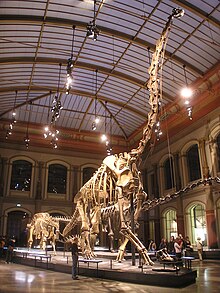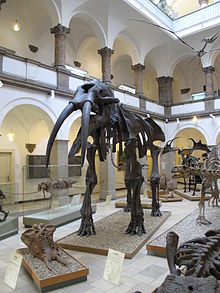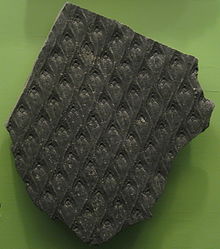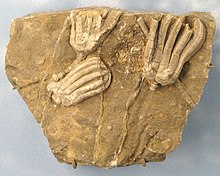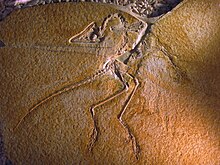Fossil of the year
The Fossil of the Year is an award that has been presented by the German Paleontological Society since 2008 for individual fossil samples or extinct species . It was created to emphasize the importance of fossils to the earth and life sciences and to take into account their aesthetic value as museum exhibits. In this way, the society wants to bring paleontology more into the focus of the German public. Both scientific importance and museum value are taken into account when selecting the annual winner from a series of proposals. The members of the Paleontological Society make the election at their annual meeting.
Award winners
| year | Copy number (s) or other designation | description | preparation | museum | Illustration |
|---|---|---|---|---|---|
| 2008 | WMf.N P62360 | Lectotype of Parapuzosia seppenradensis from the Dülmen formation ( Untercampanium ) of the Münsterland chalk basin | LWL Museum for Natural History in Münster | ||
| 2009 | JME Sch 200 | Holotype of Juravenator starki from the Solnhofen limestone ( Kimmeridgium ) of Schamhaupten | Pino Völkl | Jura Museum in Eichstätt | |
| 2010 | KH0052, KH0054, KH0057, KH0058, KH0072 | Strain of Riesenschachtelhalms Arthropitys bistriata from the Zeisigwald-Tuff ( Unterrotliegend , lower Cisuralium ) of the Vorerzgebirgs sink | Museum of Natural History Chemnitz | ||
| 2011 | "Three shark skeletons united" | Three specimens of Orthacanthus (Lebachacanthus) senckenbergianus (= Lebachacanthus colossus ) in a sandstone slab from the Meisenheim formation of the Unterrotliegend of the Saar-Nahe basin | Georg Sommer | Natural History Museum (Schleusingen) | |
| 2012 | mainly MB. R. 2181 (formerly HMN S II) | Skeleton of Giraffatitan brancai (formerly Brachiosaurus brancai ) from the Tendaguru formation (Upper Jurassic) of Tanzania | Museum of Natural History (Berlin) | ||
| 2013 | " Gweng Gomphotherium " | Largely complete skeleton of a Gomphotherium aff. steinheimense from the Upper Freshwater Molasse ( Miocene ) of Bavaria | Paleontological Museum Munich | ||
| 2014 | Seirocrinus subangularis | Collective award for the sea lily species Seirocrinus subangularis from the Lower Jurassic in Germany, England, Japan and Canada | no specific copy | no specific copy | |
| 2015 | Arthropleura armata | Collective award for the type species of the arthropod genus Arthropleura from the Upper Carboniferous and Lower Permian of Europe and North America | no specific copy | no specific copy | |
| 2016 | Leptolepides sprattiformis | Collective award for the early species of the more modern real bony fish Leptolepides sprattiformis from the upper White Jura of the Franconian Alb | no specific copy | no specific copy | |
| 2017 | Pycnodonte (Phygraea) vesiculare | Collective award for Pycnodonte vesicular that Shell art from the closer relationship of oysters , which the best known Cretaceous belongs -Fossilien Europe and u. a. is common in the Rügen chalk . | no specific copy | no specific copy | |
| 2018 | Lepidodendron | Collective award for lepidodendron (shed tree), from the group of club moss plants , a characteristic fossil of the layers of the "coal age" ( carbon ). | no specific copy | no specific copy | |
| 2019 | Encrinus liliiformis | Collective award for the sea lily species Encrinus liliiformis , a typical fossil of the "trochitic layers" of the Upper Muschelkalk ( Middle Triassic ) | no specific copy | no specific copy | |
| 2020 | JME SOS2257 | "Eichstätter specimen" of the "primeval bird" Archeopteryx from the Upper White Jura of the Franconian Alb . It is a young animal and one of the best preserved specimens of this genus. | Jura Museum in Eichstätt |
Web links
- Fossil of the Year - Website of the Paleontological Society
Individual evidence
- ↑ William James Kennedy, Ulrich Kaplan: Parapuzosia (Parapuzosia) seppenradensis (Landois) and the ammonite fauna of the Dülmen layers, lower sub-Campan, Westphalia . In: Geology and Paleontology in Westphalia . tape 33 , 1995.
- ↑ a b Ursula B. Göhlich, Luis M. Chiappe: A new carnivorous dinosaur from the Late Jurassic Solnhofen archipelago . In: Nature . tape 440 , no. 7082 , 2006, p. 329-332 , doi : 10.1038 / nature04579 .
- ^ Ronny Rößler, Zhuo Feng, Robert Noll: The largest calamite and its growth architecture - Arthropitys bistriata from the Early Permian Petrified Forest of Chemnitz . In: Review of Palaeobotany and Palynology . tape 185 , 2012, p. 64-78 , doi : 10.1016 / j.revpalbo.2012.07.018 .
- ^ A b Ralf Werneburg: Fossil of the year 2011. Geoscientific messages ( Gmit ). No. 43, 2011, pp. 17–19 ( PDF 3.2 MB; entire issue)
- ↑ a b c d e f g h Fossil of the Year: Previous awards on the website of the Paleontological Society
- ↑ Werner Janensch: The skeleton reconstruction of Brachiosaurus brancai . In: Palaeontographica . Supplement tape 7 , 1950, pp. 97-103 .
- ↑ Michael P. Taylor: Correction: A Re-Evaluation of Brachiosaurus altithorax Riggs, 1903 (Dinosauria, Sauropoda) and Its Generic Separation from Giraffatitan brancai (Janensch, 1914) . In: Journal of Vertebrate Paleontology . tape 31 , no. 3 , 2012, p. 727 , doi : 10.1080 / 02724634.2011.557115 .
- ↑ Fossil of the year 2013: Gweng Gomphotherium on the website of the Bavarian State Collection for Paleontology and Geology in Munich
- ↑ Oliver WM Rauhut, Christian Foth, Helmut Tischlinger: The oldest Archeopteryx (Theropoda: Avialiae): a new specimen from the Kimmeridgian / Tithonian boundary of Schamhaupten, Bavaria. In: PeerJ. Vol. 6, 2018, item no. e4191, doi: 10.7717 / peerj.4191
- ^ Fossil of the year 2020 on the website of the Paleontological Society




